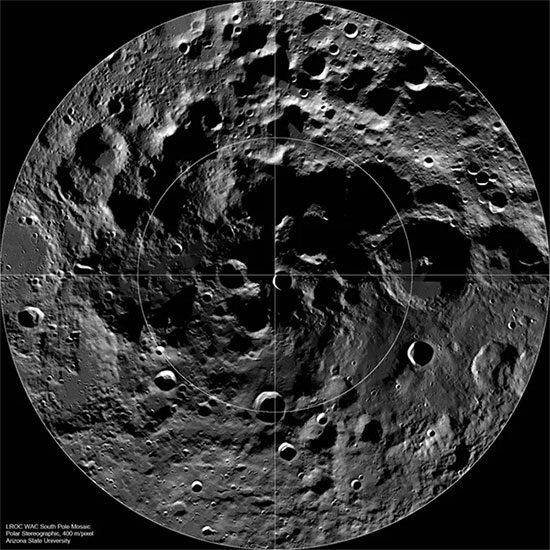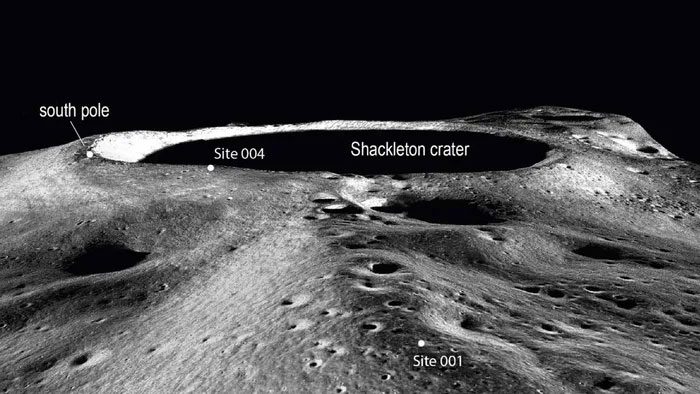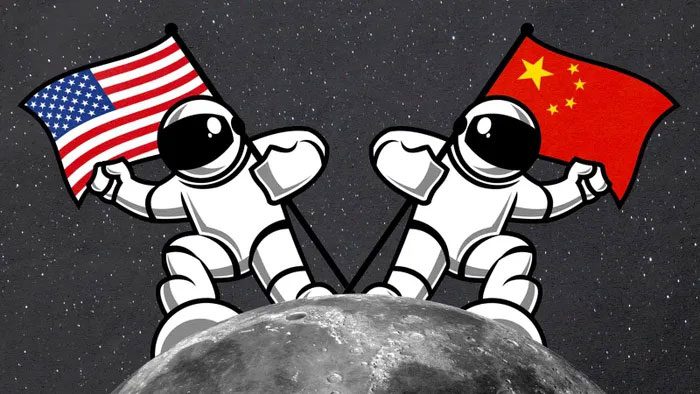Both countries aim to conduct research around the Shackleton crater near the Moon’s south pole, a suitable landing site that may harbor water.
The Shackleton Crater near the Moon’s south pole is a uniquely positioned location. Its exposed rim is continuously bombarded by sunlight, while the interior remains perpetually shrouded in darkness.
Surveys indicate that the Shackleton crater may contain frozen water, with the potential to support human life for a lunar base. This has attracted interest from both the United States and China.
U.S. policy researchers state that lunar exploration programs are currently operating independently, but they wish to keep lines of communication open with China for potential collaboration.
Significant Location
Both the U.S. IM-2 probe and China’s Chang’e 7 lander will drill one meter beneath the surface of the Shackleton crater to study samples. Each device will also carry a “scoop” to search in the permanently dark areas, including the crater’s bottom, for traces of water.
The ice could be used to generate oxygen and hydrogen, which can then be extracted to provide air, drinking water, and fuel to sustain crewed exploration efforts. This would significantly reduce costs by eliminating the expensive transportation process from Earth.

Wide angle image of the Moon’s south pole. (Photo: NASA/Arizona State University).
While similar space missions often create opportunities for nations to collaborate, the Wolf Amendment, a law passed by the U.S. Congress in 2011, has limited NASA’s ability to work directly with Chinese organizations due to concerns over technology theft.
During a budget hearing for fiscal year 2024 in April, NASA Administrator Bill Nelson stated that the law should remain in effect and emphasized concerns about a “space race” with China.
“This is where we are going, and China is going too. My concern is if China gets there first, they will claim it as their territory, and you are out of the game,” Bill Nelson said.
Challenges in Research
Roger Handberg, a political science professor at the University of Central Florida, noted that some view space “like America’s old Wild West – you seize control because you can.” Despite the competition, Handberg remains optimistic about future collaboration between China and the U.S.
“Today, everyone talks about the U.S. and China as the leading players in lunar activities. Both countries will play significant roles in deciding the rules, which means the Wolf Amendment could help make the work more efficient,” Roger Handberg stated.

The Shackleton Crater has significant temperature variation. (Photo: ETHZ).
Although finding ice on the Moon would provide an advantage, Handberg mentioned it could take a decade before either China or the U.S. develops the technology to process it. Daytime temperatures on the Moon’s surface can reach up to 120 degrees Celsius, yet it still contains deposits of ice in its permanently dark regions.
Currently, very few places on the Moon have the necessary conditions for long-term human exploration. The exploration team will need continuous sunlight to power vehicles and bases on the Moon, while the bottom of the Shackleton crater remains in perpetual darkness.
In 2021, NASA and the IM company announced they would develop a commercial lunar lander to deliver an ice drill to an area called the Shackleton connecting ridge, just west of the crater.
“This area receives enough sunlight to power the lander for a 10-day mission while providing clear visibility back to Earth for communication,” NASA stated.
In contrast, China has not yet officially announced a landing site for the Chang’e 7 mission. However, according to Wu Yanhua, the chief designer of China’s space exploration program, the area around the Shackleton crater is also a top target for the country.
Articles published in various journals also indicate China’s strong interest in exploring the Shackleton crater. It ranked as the most favorable location in a 2020 analysis of areas suitable for landing at the Moon’s south pole.
U.S.-China Collaboration
Despite the high value of the south pole to scientists and explorers, its surface is uneven and poses significant challenges for landing. “It’s a dangerous place to land and there’s very little valuable real estate you’re risking,” Nelson remarked.
In August, NASA announced it had selected 13 potential landing sites for the Artemis III mission. Planned for after 2025, this mission will mark humanity’s first return to the Moon in half a century. Additionally, it will be the first time astronauts explore the Moon’s south pole.

Scientists suggest that the two countries should consider collaborating to address challenges in lunar exploration. (Photo: The Week).
Researchers in China have also identified several preferred landing areas in the south pole, which likely overlap with NASA’s selections. The country hopes to land astronauts on the Moon by 2030.
However, even if the landing sites are somewhat “overlapping,” mission conflicts are unlikely to occur. Each site covers more than 100 square kilometers and has multiple touchdown points. The U.S. and China are also assembling their own camps under the Artemis Agreement and the International Lunar Research Station.
“While major players will lead in specific areas, they should interact to coexist because the lunar environment is very harsh and unforgiving,” Handberg noted.
Brian Weeden, Director of Strategy for the Secure World Foundation, a Washington-based consultancy, also urged the U.S. government to resume bilateral cooperation with China.
“Congress should reconsider the Wolf Amendment to allow NASA to participate in space activities with China to support U.S. interests,” Weeden stated.





















































